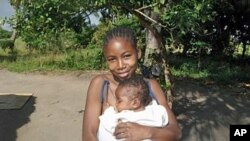Teenage girls in sub-Saharan Africa are three-to-five times more likely to be infected with the virus that causes AIDS than boys their age. A new study in Malawi, Mozambique and Botswana explores why that is.
Carol Underwood, senior research scientist at Johns Hopkins University's Bloomberg School of Public Health, directed the initiative called Go Girls!.
She says community meetings helped define the problem. “We found that girls who were orphans, who were not in school or never attended school, who live in impoverished conditions or are socially isolated are more likely to be HIV-positive.”
According to Underwood, girls who don’t have supportive relationships with adults are also more likely to be HIV-positive.
A 14-year-old girl from Malawi named Mary fits that profile. Orphaned after her parents died, Mary tried supporting herself by home-brewing beer on the street. Willard Mwambo, who put “Go Girls!” in place in Malawi, shared Mary’s story at a briefing in Washington.
In a country where 15 percent of the population has the virus that causes AIDS, Mwambo says Mary was at great risk. She couldn't support herself and made bad decisions.
“Her solution was the wrong one," he says. Mary sold sex for money, got pregnant and dropped out of school. “And again the situation was so tough because she was failing to divide time, time to process beer and time again to take care of the baby."
Things began to change after Mary attended a Go Girls! community meeting. Mwambo says such meetings - at the heart of the program - empower locals to solve problems. “And that’s when she heard about the importance of going to school. She learned that it is possible that even if someone has a baby, she can go back to school.”
Mary’s aunt was also at the meeting, where she was encouraged to help Mary, who has since stopped selling beer, quit prostitution and returned to school, with hopes of becoming a nurse.
Johns Hopkins University Bloomberg School of Public Health - with support from the U.S. government - used that research to set up a community program with one mission: to keep girls out of harm’s way.
Underwood says the findings led to actions to protect girls. “We developed structural interventions to make schools safer. And we also worked on what we call legal literacy, getting communities to become aware of laws that are on the books to protect girls and also empowering them to take action to make sure that those laws are in force.”
Underwood adds that Go Girls! also helped foster better parent-adult-child-communication and among girls themselves to increase their knowledge about HIV. She says country reports document changes in how girls are cared for at school and at home.
“And in those schools where we worked we found that girls felt safer than in the schools where we didn’t work. We also found that girls said teachers’ demands for sex in exchange for good grades or favors had decreased in the schools where we worked. We found that there was an increase in legal literacy among adults and girls over time.”
Malawi youth organizer Willard Mwambo says Go Girls! works because it empowers community residents to take charge. “You can say it’s everybody’s responsibility in the community to at least protect the girl child.”
Funding for Go Girls! expires this month. Organizers are hoping United Nations agencies, the U.S. Peace Corps and other groups will not only continue the efforts, but expand their reach to other countries where adolescent girls are at high risk from HIV/AIDS.











